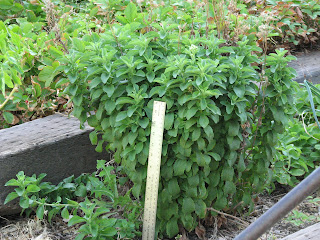Dear Folks,
I've written about Stevia before, but my plant was looking so gorgeous the other day, I thought it was time to talk about this fascinating herb again.
I took the picture June 2nd and that ruler is a 15 inch one to give you a size reference.
This plant has re-grown for about 5 years and is one of my favorite successes in our desert garden.
Stevia Stevia rebaudiana is a member of the greater sunflower (Asteraceae) family and is native to Paraguay. It was “discovered” by the Europeans about 400 years ago, but has been used by the native people for 1500 years where it is sometimes called the honey herb.
Unlike essential oils which flavor our beloved herbs, Stevioside and Rebaudioside (the glycocides which gives the sweetness to Stevia) are an element and more stable than an essential oil. Dried Stevia remains sweet for years.
It is a subtropical plant and notoriously difficult to grow from seed. In my warmer valley location garden (250 chill hours on average) I have several plants which return from dormancy early March each year, including 2 volunteer seedlings, meaning I now have 1st generation adapted plants for which I am very grateful.
12-20+ times sweeter than sugar, Stevia can be used fresh, dried or as liquid to flavor foods and beverages (steep like tea, refrigerate and use up in 5 days). The commercial processed Stevia is concentrated to increase the sweetness up to 300 times more than sugar, but tends to bring forward a natural back note of licorice and can be bitter to many people. The fresh or dried leaf is not bitter.
The plant grows through the summer and starts to flower in the fall. It will benefit from afternoon shade in the summer.
My Stevia Recipe Notes.
Fresh or dried Stevia leaf is at least 10-12 times sweeter than sugar. This form differs dramatically from the processed form which winds up a powder or liquid. The processing is intended to increase the sweetness ratio, however for many folks it winds up with an aftertaste. This is a shame since one of the attractions of Stevia (beside the fact that it is natural) is its ‘clear’ taste, with no bitter aftertaste such is found in artificial sweetners.
Stevia is stable in hot and cold cooking and is considered safe for diabetics because it is an element, not a sugar, and does not impact the insulin production in the body.
A small piece of leaf is all most people need to sweeten a cup of tea or coffee.
To substitute use the below ratios as a starting point. Each person’s perception of sweet varies so you may need less or more depending.
Ratio: Begin with 1/2 to 1 1/2 tablespoons of the dry leaf substitute per 1 cup of sugar.
Dry Rubs (herb/spice mixes): for grilling meats and vegetables call for sugar--substitute 1/2-3/4 tsp stevia leaf for each tablespoon of sugar, mix or grind well to blend.
Baking: when substituting stevia for sugar, you need to replace the bulk which granular sugar provides in addition to sweetness – try any pure (nothing added) fruit purees such as applesauce, apple butter, prune whip, or yogurt. (Note: if you need to reduce egg or oil in a recipe for health purposes these same ingredients can be substituted.)
Steep the Stevia in the liquid you will use for baking. If you do not want the green “floaties” in your baking, strain and proceed with the recipe — remembering to replace the bulk of sugar as noted above.
Sauces, Salads, and Dressings: If you commonly put a pinch of sugar in your cooking, crumble a bit stevia leaf instead.
Homemade Stevia Liquid Sweetner: Steep 1/2 teaspoon of stevia in 1/2 cup of hot or just boiled water for 30 minutes. Strain and keep the liquid in the refrigerator for up to a week. Use to sweeten beverages or where a little drop of sweet liquid will work (like just made salad dressings). Like a tea bag, Stevia steeped in water can be re-used to make another batch of sweet liquid. It may not be quite as sweet as the first batch, but you can get every drop of sweetness from the leaves, doing a second steeping.
Sun Tea: 1/4 cup of Stevia leaves to a ½ gallon added to whatever mix of herbs and teas you desire.
A word about the Commercial Stevia Sweeteners:
Tru-Via and Pur-Via are adulterated "versions" of Stevia, and they are not the only ones. Not only did they super concentrate the Stevia used, but they added "natural flavors" (they won't tell you what they are).
Rumor has it that these same companies are reportedly preparing to create an Artificial Stevia Genetically Engineered product. Ick!!!
I generally recommend "Sweet Leaf" Stevia powder to those who want to have a handy to-go sweetener when you are out dining. It has only Stevia and the soluble fiber Inulin.
Amazon and other sellers carry my gardening calendar and books. Find links on my website or here on the side bar.
-- Catherine, The Herb Lady
If you enjoyed this post, subscribe in the upper side bar link, to get all my posts!
Disclaimer: Clicking on links on this blog may earn me a small commission if you purchase something. Your price does not change.
Wednesday, July 06, 2016
Subscribe to:
Posts (Atom)






















